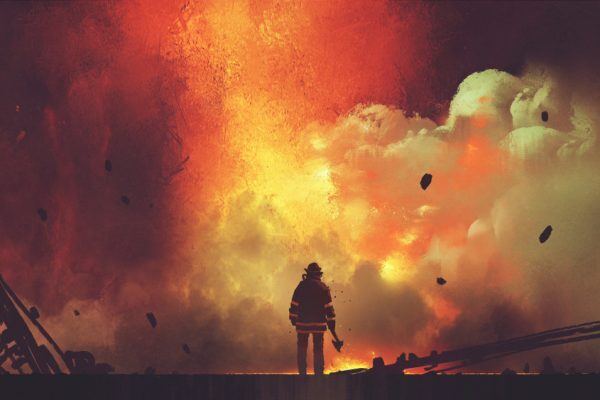California Firefighters are tasked with some of the most difficult jobs. California is perhaps the Forest Fire Capitol of the United States or even the World! Firefighters provide a vital services in ensuring that we live in safety.
In performing their duties, Firefighters get hurt and have industrial claims. California Firefighters’ work injuries have been studied by the Rand Corporation and they have prepared a recent report. The study is entitled The Frequency and Economic Impact of Musculoskeletal Disorders for California Firefighters: Trends and Outcomes of the Past Decade, Dworsky, Seabury, and Broten.
This article will address the most recent Rand Corporation Study and what it means to Firefighter and their careers with respect to their work injuries.
What Is the Rand Corporation? What Did It Study?
Rand Corporation is commonly known as a “think tank.” According to Rand, it “was established over 70 years ago to strengthen public policy through research and analysis. Over seven decades, our research teams have answered the difficult questions and generated actionable insights by combining the very best analytical tools and methods with a distinct, interdisciplinary approach.” They are frequently used by government, such as the State of California to do research. The term “public policy” implies that their results can impact laws and proposed legislation. For our purposes, their conclusions may become the impetus for new changes in workers’ compensation law.
The Rand Corporation Study, with respect to California Firefighters was done with “[t]he purpose of this report was to provide new information to policymakers about the frequency, nature, and consequences of firefighter injuries in California, with a particular focus on MSDs.” In other words, the State of California may use the data to change workers’ compensation law with respect to Firefighters, or Fire Departments may change their risk management approaches to attempt to reduce claims.
What Did the Rand Study Find?
Highest Rate of Injuries
The Rand Study found that “firefighters are significantly more likely to be injured than workers in other occupations.”
Highest Rate of Musculoskeletal Disorders (MSDs)
The Rand Study found that “ a larger share of those injuries are MSDs.”
Specifically, we found that nearly half (47 percent) of firefighter injuries are MSDs, compared to 38 percent for police officers, 42 percent for other public-sector workers, 37 percent in our private-sector comparison group with similar job requirements to firefighters, and 42 percent for other private-sector workers.
Spine and Knee Injures Are More Common Than Upper Extremity Injuries
The Study found that there were “differences in the nature and cause of firefighter injuries. Compared to other occupations, injuries to firefighters are less likely to involve the upper extremities and significantly more likely to involve lower extremities or the trunk. Strains are the modal cause of injury for firefighters.”
Burn Injuries Are More Significant Than Other Occupations
The Rand Study found that “burns are significantly more common among firefighters than other workers but still represent a small share of injuries (6 percent) in comparison to MSDs.”
Cumulative Trauma vs. Specific Dates of Injury
The Rand Study found that “a lower share of firefighter injuries were reported as being due to cumulative trauma than workers in other occupations.”
Psychiatric Injuries for Firefighters
The Rand Study shows that the dated indicated that “firefighters and police have similar rates of psychiatric comorbidities. However, perhaps surprisingly, incidence rates of psychological injuries—including PTSD—for public safety workers are substantially lower than rates observed among other public-sector workers or comparable private-sector workers.”
Note: as noted in the study, Firefighters may carry with them a stigma concerning mental health issues. Firefighters with mental health concerns may seek treatment privately rather than file a work injury claim.
Is There Any Good News for Firefighters with respect to the Study?
There was some good news in the Rand Study for Firefighters. The economic consequences of musculoskeletal disorders was less serve than for other similar occupations. It was noted the Fire Departments appear to do better than other employers, including other public sector employers, at retaining Injured Workers. Also, SB 863, a recent law change, provided for higher ratings for MSD injuries for Firefighters. Finally, there was no evidence found that treatment caps for chiropractic, occupational therapy, or physical medicine treatments did not substantially impact most Firefighters.
What is there to Make of the Rand Study?
In light of the findings, it would appear that there would be no effort to try to increase additional indemnity to Firefighters. Further, it would appear that there would be no effort to change treatment protocol as well. Perhaps, injury rate reduction would be explored. In sum, risk management for the departments may try to take steps to reduce injuries. Any reduction may be difficult to achieve due to the job’s physical demands.
What if I Need Advice?
If you would like a free consultation regarding workers’ compensation, please contact the Law Offices of Edward J. Singer, a Professional Law Corporation. We have been helping people in Central and Southern California deal with their workers’ compensation cases for 27 years. Contact us today for more information.
